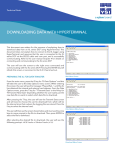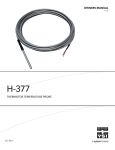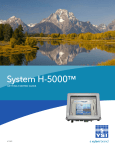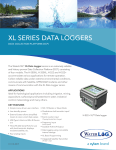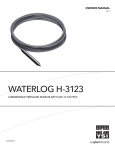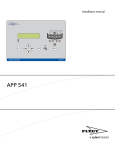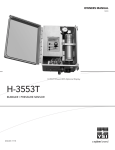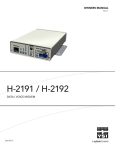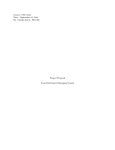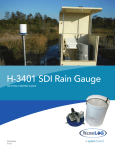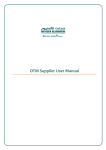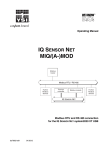Download (H-4400) Manual
Transcript
OWNERS MANUAL V1.2 REV. G OR LATER H-4400 Series RS-232 DATA RADIO D54-02 0615 CONTENTS & WARRANTY This user manual is a guide for the H-4400 Line-of-Sight Radio Series. For more information, updated manuals, brochures, technical notes, and supporting software on the H-4400 Series please refer to waterlog.com or contact your sales representative. For additional assistance, please contact us at +1.435.753.2212 or [email protected] WaterLOG® Warranty.........................................................................1 Chapter 1: Introduction.....................................................................2 Operation......................................................................................3 Using the H-4400 as a Repeater ................................................3 Connecting the Antenna ...........................................................4 Troubleshooting ..........................................................................5 FCC Restrictions ..........................................................................6 Contents & Warranty “WATERLOG™ PRODUCTS MANUFACTURED BY YELLOW SPRINGS INSTRUMENTS CO., INC. are warranted by Yellow Springs Instruments Co., Inc. (“YSI”) to be free from defects in materials and workmanship under normal use and service for twelve (12) months from date of shipment unless otherwise specified in the corresponding YSI pricelist or product manual. WaterLOG™ products not manufactured, but that are re-sold by YSI, are warranted only to the limits extended by the original manufacturer. Batteries, desiccant, and other consumables have no warranty. YSI’s obligation under this warranty is limited to repairing or replacing (YSI’s option) defective products,which shall be the sole and exclusive remedy under this warranty. The customer shall assume all costs of removing, reinstalling, and shipping defective products to YSI. YSI will return such products by surface carrier prepaid within the continental United States of America. To all other locations, YSI will return such products best way CIP (Port of Entry) INCOTERM® 2010, prepaid. This warranty shall not apply to any products which have been subjected to modification, misuse, neglect, improper service, accidents of nature, or shipping damage. This warranty is in lieu of all other warranties, expressed or implied. The warranty for installation services performed by YSI such as programming to customer specifications, electrical connections to products manufactured by YSI, and product specific training, is part of YSI’s product warranty. YSI EXPRESSLY DISCLAIMS AND EXCLUDES ANY IMPLIED WARRANTIES OF MERCHANTABILITY OR FITNESS FOR A PARTICULAR PURPOSE. YSI is not liable for any special, indirect, incidental, and/or consequential damages.” A complete TERMS AND CONDITIONS OF SALE can be viewed at: http://www.ysi.com/terms-and-conditions.php 1 01 / 2 INTRODUCTION Introduction The WATERLOG® H-4400 is a spread spectrum RS-232 radio bridge. The H-4400 radio link is often used to interface a data recorder with a remote “point-of-sale” display. The display allows water level data to be displayed at a project office or other location remote from the data recorder and water level sensing equipment. The radio link uses modern direct sequence spread spectrum telemetry radios. Spread spectrum technology is highly secure and has good interference immunity. The radio operates in the license-free 900 Mhz ISM Band. Two or more H-4400 modules are required; one connected to the data recorder (master) and one or more located at the remote (slave) sites. With the H-4400 all radios are identical which means there is no master or slave radio. No device addresses or setup is required, the each radio broadcasts to all other radios. The radio internal to the H-4400 has an electronic switch with controls the power mode of the radio. This switch will either set the radio to either full power or power-save operation. When the switch is set to “On” the radio is powered continuously and draws approximately 18mA. When the jumper or switch is set to “Auto” the power is controlled by the RS-232 DSR input signal (pin-4) or when the radio detects incoming data. Operation The H-4400 operates as a transparent 9600-baud RS–232 radio bridge. No programming or special setup is needed. The radio supports an always on or automatic pin the slave station(s) may need to be set to “On”ave sites must be powered continuously or they will miss the data transmissions. The radio in the master station can be jumpered for either “Always On” or “External (DTR)” depending on your application. If the master station is connected to a data logger, the External DTR control setting should be used to save power. If the external power control mode is selected, the data logger must assert its DTR output before and during the transmission. Note a standard RS-232 cable normally connects pin-4 (DTR) of a data terminal equipment (DTE) device [your data logger] to pin-4 (DSR) of a data communications equipment (DCE) [the H-4400]. Using the H-4400 as a Repeater The spread spectrum radios require “line of sight” between the transmitter and receiver. For installations where this is not practical a H-4400 can be configured to operate as a repeater. The radio in the H-4400 has an internal buffer on its RS-232 input. If the RS232 transmit and receive signals are connected together the radio buffers, then re-transmits (echos) the RS-232 string. Bursts of up to 64 characters can be buffered. 3 INTRODUCTION The repeater system works as follows: 1. The master station is powered up when the data recorder asserts DTR. 2. The data recorder sends a short RS-232 message string. 3. The master radio transmits the message string. 4. The repeater receives the message string. 5. The message string is routed back to the transmitter of the repeater with the loopback connection 6. The repeater radio re-transmits the message. 7. Both the master and slave stations receive the message. This scheme works because data transfer is only unidirectional. The echo back to the master station is ignored by the data recorder. Note: Depending on conditions the radio signal from the master station may sometimes be received directly by the remote slave station. In this case the slave will receive two copies of the RS-232 message, one from the master, the other from the repeater. When using the radio link for a pointof-sale display, this will not cause a problem. The display will simply update twice with the same message. This simple radio link cannot be used with more than one repeater, the RS-232 message would bounce endlessly back and forth between additional repeaters. Configure the repeater station as follows: 1. Set the power control jumper of the repeater to “On”. This causes the radio to be powered continuously. 2. Install a special loopback connector on the RS-232 connector of the radio. 3. Make certain your +12V power source can provide 18mA continuous, up to 200mA for short bursts. Connecting the Antenna The H-4400 may be used with a 50-ohm, 900 Mhz antenna providing the effective radiated power is 6dB or less. The antenna connector is a reverse type-TNC connector which is required to meet FCC part 15.203 regulations. A simple vertical whip antenna will work up to 2 or 3 miles. Longer distances require a directional antenna with gain. A 6dB or 9dB YAGI will work fine, do not use a 12dB model. At 900 MHz, RG58 type coaxial antenna feed lines have excessive loss (1.8dB/10 feet). Consider using newer low loss RF cable such as Times Microwave LMR-400 or similar (0.8dB/10 feet). The LMR-400 requires special RG8 connectors. 4 Introduction The H-4400 is packaged in a weather tight enclosure and is best mounted as close to the antenna as possible. The H-4400 has a ground lug which should be connected to a good earth ground with a heavy copper wire. The ground helps provides lightning protection for the radio, your sensors and the data logger. The H-4400 radios all operate at the same frequency. If multiple data logger sites are deployed, make certain the radios of each separate logging site cannot “hear” each other. The radios can be ordered with alternate frequencies, please contact the factory for further information. Words of caution: • Even though the master H-4400 operates in a low power mode, the transmitter requires up to 200mA for short bursts. Make certain your wiring and battery is capable of supplying sufficient current. • Keep the lead wires as short as possible. • Use shielded cables in noisy environments. • Connect the ground post to a good earth ground. Troubleshooting The radios can be difficult to field test when operating with a data logger due to the intermittent short bursts of data. The radio system can be more throughly tested with the aid of a lap-top computer or RS-232 terminal. With the following setup you can transmit ASCII messages or other test data while adjusting or aligning the antennas. The radio link is tested by connecting a computer terminal to one radio and connecting a loopback connector to the other. With this setup, one person can test both up-link and down-link communication paths. The radios have a standard RS-232C interface which operates at 9600 baud. With a straight-thru 9-pin RS-232 cable, connect one of the radios to a laptop computer or terminal. The radios have a female DB9 connector, pin-2 is received data output and pin-3 is transmit data input. The other radio in the link to be tested must be setup for loopback operation. Do this by installing a loopback test connector or connecting a jumper between pins 2 & 3. Set the power control switch of both radios for “On”. The wireless link is best tested with a test program provided by the radio manufacturer. The test program “X-CTU” can be downloaded from the www.digi.com website. X-CTU automatically tests the wireless link and provides a success/fail display of each data packet. Make sure your computer is set for full-duplex, 9600 Baud. Alternatively, you can use a serial terminal emulator program such as Hyperterminal or Tera Term to test the radio link. Make sure your computer or terminal is set for full-duplex, 9600 Baud. Test the radio link by typing characters and checking for the proper echoed response. As you type, the characters are transmitted to the remote station then re-transmitted back to the local station and displayed on your screen. Both up-link and down-link paths are tested at the same time. 5 INTRODUCTION FCC Restrictions This equipment has been tested and found to comply with the limits for a Class B digital device, pursuant to Part 15 of the FCC Rules. These limits are designed to provide reasonable protection against harmful interference in a residential installation. This equipment generates, uses, and can radiate radio frequency energy and, if not installed and used in accordance with the instructions, may cause harmful interference to radio communications. However, there is no guarantee that interference will not occur in a particular installation. If this equipment does cause harmful interference to radio or television reception, which can be determined by turning the equipment off and on, the user is encouraged to try to correct the interference by one or more of the following measures: • Reorient or relocate the receiving antenna. • Increase the separation between the equipment and receiver. • Connect the equipment into an outlet on a circuit different from that to which the receiver is connected. • Consult the dealer or an experienced Radio/TV technician for help. Declaration of Conformity to Part 15, subpart B The following declaration applies: Digi International model Xbee-PRO frequency hopping spread spectrum transceiver. This device complies with part 15 of the FCC rules. Operation is subject to the following two conditions: 1. This device may not cause harmful interference, and. 2. This device must accept any interference received, including interference that may cause undesired operation. The responsible party for this declaration is: Digi International. 11001 Bren Road East Minnetonka, MN 55343 (952) 912-3444 6 Xylem 1) The tissue in plants that brings water upward from the roots; 2) a leading global water technology company. We’re 12,000 people unified in a common purpose: creating innovative solutions to meet our world’s water needs. Developing new technologies that will improve the way water is used, conserved, and re-used in the future is central to our work. We move, treat, analyze, and return water to the environment, and we help people use water efficiently, in their homes, buildings, factories and farms. In more than 150 countries, we have strong, long-standing relationships with customers who know us for our powerful combination of leading product brands and applications expertise, backed by a legacy of innovation. For more information on how Xylem can help you, go to www.xyleminc.com YSI Incorporated 1700/1725 Brannum Lane Yellow Springs, Ohio, 45387, USA Request a Quote Tel: Email: Internet: +1.435.753.2212 [email protected] www.waterlog.com Place an Order Tel: Email: +1.937.767.7241 [email protected] Customer Support Tel: +1.937.767.2772 H-3342 and YSI is a trademark of Xylem Inc. or one of its subsidiaries. © 2015 Xylem, Inc. D54-02 0615









